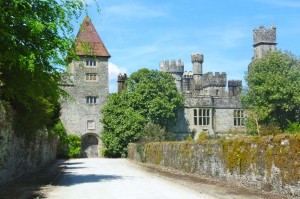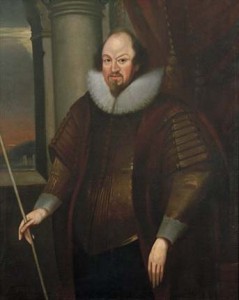Reconstructing the estate of Richard Boyle, first earl of Cork, c. 1602–43
Published in Early Modern History (1500–1700), Features, Issue 2 (March/April 2015), Volume 23Richard Boyle was one of the most significant and controversial characters in early modern Ireland. An archetypal English adventurer, by his own account he was variously an earnest royal official who rose through the ranks to reach the very top of government through sheer ability; a successful entrepreneur and industrialist; a great landowner, having acquired vast estates across the south and west of the country; the proud founder of a major new aristocratic dynasty; and a pious Protestant. But in the eyes of his enemies (and there were many) he cut rather a different figure. To them he was a scoundrel of the worst sort, an inveterate liar and a cheat who stole most of the vast fortune he made.
Social upstart
Perhaps worse, he was also a social upstart. The son of a Kentish yeoman, he had arrived in Ireland in 1588 with just under £30, a gold bracelet and a diamond ring to his name, but when he died at Lismore Castle in 1643 he was reputed to be the richest of the crown’s subjects in the three kingdoms. Moreover, this material success was matched by a remarkable social and political ascent. From the bestowal of a knighthood on him in 1603, he successively acquired titles throughout his career, becoming first baron of Youghal in 1616 and first earl of Cork in 1620. In the political sphere he progressed from membership of the regional council of Munster in 1607 to the Irish privy council in 1613 before serving in the vice-regal office as joint lord justice of Ireland between 1629 and 1633. Finally, in 1640 Boyle ascended to the highest political body in the three kingdoms when he was appointed to the English privy council. Nevertheless, despite all his material, social and political success, Boyle struggled to gain acceptance among his peers, who tut-tutted in private about his humble origins and lack of proper breeding.

Boyle is responsible for the layout of Lismore Castle, Co. Waterford, as it is seen today, including the addition of a castellated outer wall and the Riding Gate.
It is evident that Boyle divided opinion, but exactly why he did so is just one of the many questions being explored by ‘The Colonial Landscapes of Richard Boyle’ project at University College Cork. Ultimately the controversy surrounding Boyle related to the manner in which his startling land acquisitions, mostly in Munster but also in Leinster and Connacht, had accompanied and facilitated his rise to eminence. In the south he acquired over 100,000 acres of land across all six counties, through which he and his client network dominated the province. In Connacht he held possessions in all five counties, while in Leinster he acquired holdings in a stretch of land running through Offaly and Kildare to Dublin, where his residence, Cork House, stood in the shadow of Dublin Castle. Altogether he obtained lands in at least seventeen counties in Ireland, along with a number of holdings in England. But Boyle did not simply acquire land. He used it to thoroughly dominate the regions into which his influence stretched, a strategy which was manifested most palpably in the development of a series of regional towns and strongholds. In Waterford and east Cork his two major residences, the College House at Youghal and his family seat at Lismore Castle, became the focal points for Boyle’s oversight of the towns of Dungarvan, Lismore, Tallow, Ardmore and Youghal, and the landscape of the Blackwater Valley. Further west he acted as one of the pioneering founders of the town of Bandonbridge, which became the most important newly established settlement in the Munster Plantation, while to the north Fermoy firmly felt Boyle’s influence after he acquired extensive landholdings there in 1625.
Corruption?
Contemporaries questioned how Boyle had come by such extensive possessions. In particular, critics looked quizzically at his career in the 1590s, when he was deputy-escheator. His role was to uphold the crown’s rights to lands in places as disparate as Wexford and north Mayo, Westmeath and Kerry. Entrenched in a notoriously corrupt Irish officialdom, however, Boyle’s over-riding concern while in office was his own, rather than the crown’s, interest. Widely suspected of acute corruption, he was imprisoned on seven occasions between 1594 and 1599 and was accused of having contributed significantly to the rebellion in Connacht. What was more, the circumstances in which he had obtained his own personal estate in Limerick were extremely murky. This was acquired through his marriage in 1595 to Joan Apsley. Joan, however, had inherited the lands upon the death of her brother, Edward, whose apparent suicide should have led to forfeiture of the Apsley estate to the crown. The question was posed: had Boyle attempted to conceal the fact of Edward’s death by suicide in order to obtain the estate himself? Finally, critics wondered how Boyle had acquired the £1,500 with which he purchased Walter Raleigh’s 42,000-acre Munster Plantation estate in 1602, and, indeed, how the transaction had even been negotiated. Plainly there were more than enough grounds for questioning the legality of Boyle’s dramatic ascent. As a result, reservations about his rise to prominence continued to overshadow him down to the 1630s, when opponents such as Lord Deputy Thomas Wentworth (1633–41) attempted to exploit them to ruin the earl.
There are many other reasons for examining Boyle’s estate. Owing to a shortage of surviving estate records for Irish landholders of the period, a detailed study of the acquisition, settlement, management and exploitation of a Plantation-era estate has not previously been attempted. Unfettered access to Boyle’s vast archive makes possible such a study. What emerges is that Boyle’s plantation, once perceived as a model English settlement, was more complex. Far from being exclusively English and Protestant, it was heavily populated by Irish tenants in places, particularly in west Cork and Kerry. That said, the manner in which Boyle developed the economic potential of his lands surpassed the expectations of contemporary English observers. Of particular note was the manner in which Boyle provided for the security of the settler interest in Munster. Examination of his estate papers reveals a network of army captains commanding a large plantation militia that could be mustered at short notice across Waterford, Cork and Kerry. At the outbreak of the 1641 rebellion in Munster the insurgents encountered some of the stiffest opposition they would face anywhere in the country in those regions controlled by the earl. His sons would continue to dominate much of Munster long after Boyle’s own time.
David Heffernan is Research Assistant for the Irish Research Council-funded ‘The Colonial Landscapes of Richard Boyle, First Earl of Cork, c. 1602–1643’ project at UCC.
Read More: The project
Boyle Archive
‘Digital Boyle’
Further reading
N. Canny, The upstart earl: a study of the social and mental world of Richard Boyle, first earl of Cork, 1566–1643 (Cambridge, 1982).
A.B. Grosart (ed.), The Lismore Papers (two series, 10 vols) (London, 1886–8).
M. MacCarthy-Morrogh, The Munster Plantation: English migration to southern Ireland, 1583–1641 (Oxford, 1986).
T.O. Ranger, ‘Richard Boyle and the making of an Irish fortune, 1588–1614’, Irish Historical Studies 10 (39) (March 1957), 257–97.

















